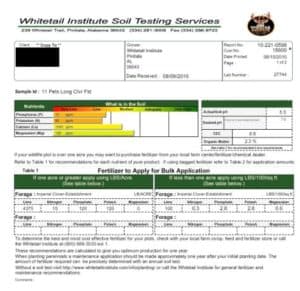by Dave Hart
Planting a food plot is the rage these days. It seems like every deer hunter with a few acres of land plants a patch of clover, beans or wheat in an effort to attract and hold deer.

Before you can enhance your wildlife and deer quality with food plots, you should enhance the quality of your soil. Follow the exact directions on your soil test kit in order to get the most accurate results and recommendations.
For the most part, those food plots work great. Some, however, not only fail to attract deer, they are little more than a feeble patch of stunted, yellowing plants. Deer won’t touch them. That’s probably because the plants don’t have the proper nutrients or the soil does not have the right pH level.
Why Test?
The best way to improve a struggling food plot is to provide it with the right amount of fertilizer and lime. The only way to determine how much fertilizer and lime you need is to conduct a soil test. It will tell you exactly what your food plot plants need to reach their full potential.
“There isn’t a farmer in the world that doesn’t conduct a soil test before he plants something,” says Whitetail Institute vice-president Steve Scott. “Farmers want to know exactly what their plants need to get a maximum yield. Deer hunters should do the same thing.”
You could spread a common bagged fertilizer like 10-10-10 and have decent results in your food plot, but then, you may not. A soil test conducted by a professional laboratory will analyze your soil’s nutrient content and offer pin-point recommendations for specific amounts of nitrogen (N), phosphorous (P) and potassium (K), the three nutrients in fertilizer. It will also tell you how much lime you need.
A Matter of Money
A $20 soil test will also save you money, says Scott. Some plants, clover, for example, don’t need much nitrogen. They actually add nitrogen to the soil through the normal growing process. Wheat and other grasses like oats require more nitrogen, so an even fertilizer like 10-10-10 fails to provide enough of the right nutrients to those grasses. On the other hand, adding nitrogen to clover is equally wasteful. You may not need any lime in your food plot, either.
“Putting down too much of a specific nutrient might even actually damage the plants,” says Scott. “Even if it doesn’t, you are certainly wasting money on something your plants don’t need.”
It’s also harmful to the environment. Excess fertilizer ends up in streams, creating water quality issues that are harmful to fish and other aquatic residents.
What You Get
Soil test kits are available through local agricultural extension offices, farm service stores and even Whitetail Institute. Do-it-yourself soil test kits are available from a variety of sources, including garden stores and even big box hardware stores with a gardening section. Those DIY kits aren’t worth the money, says Scott. Not only are they relatively unreliable and inaccurate, they won’t give you specific recommendations for each nutrient your soil needs for the food plot seeds you intend to plant.

A proper soil test, one that is sent away to a lab for analysis, will tell you exactly what you need for the specific plant you want to grow in your food plot.
“Get a soil test kit that is sent off to a lab,” says Scott. “You will get a specific analysis and recommendation for the exact plant you intend to put in your plots. Our soil test kits are geared toward each one of our products. If you want to plant Winter Greens, you get results that tell you exactly what fertilizer to use for that product. The same thing for Imperial Clover or any other seed product we sell.”
The results will be printed on a sheet of paper that offers clear details of your soil analysis. It will tell you how much N, P and K are already in your soil and it will tell you your soil’s current pH level. It also spells out the amount of each nutrient and lime your soil needs on a per acre basis to grow a specific type of plant. Some sample results include amounts per thousand square feet, as well, since many food plots are smaller than an acre. You’ll just have to calculate the size of your food plot and figure the pounds-per-acre rate of nutrients before you buy any fertilizer or lime.
“If you have a farm service company nearby, you can take the test results to them and they can figure out how much you need as long as you have a good idea of the size of your plots. They keep separate batches of each nutrient and they can custom blend to the exact specifications of your soil test recommendations,” explains Scott. “Just take the test results to them and they will take it from there.”
If that’s not an option, some labs will include a “close enough” recommendation for bagged fertilizer like 10-10-10 or 20-20-20. You may have to use a variety of types to achieve the recommended nutrient levels, but it will provide you with a food plot that will actually attract deer. If your plots aren’t reaching their full potential, why bother planting them at all? A soil test will tell you exactly what you need.
The Union Sportsmen’s Alliance website is designed to provide valuable articles about hunting, fishing and conservation for members of AFL-CIO affiliated labor unions and all sportsmen and sportswomen who appreciate hunting and fishing and want to preserve our outdoor heritage for future generations. If you would like your own story and experience from the outdoors to be considered for our website, please email us at USAmembers@unionsportsmen.org.



